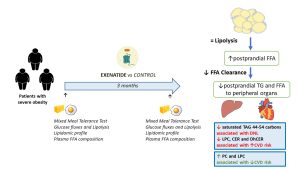Background: Glucagon-like peptide-1 (GLP-1) is a postprandial hormone with a short half-life. GLP-1 receptor agonists (GLP-1RAs) reduce cardiometabolic risk (CMR), but if this is due to changes in postprandial lipid flux and lipidomic profile, or secondary to weight loss and better glucose control, is unknown. Thus, we investigated how the short acting GLP-1RA exenatide (EXE) changed lipid composition and fluxes during fasting and after a meal tolerance test (MTT) in adults with severe obesity without diabetes. Material and Methods: Thirty individuals (26F/4M, 30-60 years old, BMI>40 kg/m2, HbA1c=5.76%) were assigned (1:1) to diet without (CT, n=15) or with exenatide (EXE, n=15, 10μg twice-daily) for 3 months. Fasting and postprandial (6-hour MTT/tracer study) lipolysis, free fatty acid (FFA) clearance and lipidomic profile (by LC/MS-QTOF) were evaluated at baseline and after 3 months in EXE vs CT. Results: Both groups decreased body weight (EXE: -5.5% vs CT: -1.9%, p=0.052). During fasting, EXE reduced some ceramides (CER) and lysophosphocholines (LPC) previously associated with CMR, while relatively increasing unsaturated phospholipid species (PC, LPC) with protective effects on CMR, although concentrations of total lipid species were unchanged. During MTT, both groups suppressed lipolysis equally to baseline, but EXE significantly lowered FFA clearance resulting in reduced postprandial triacyclglycerols (TAG), particularly saturated TAGs with 44-54 carbons. Exenatide also reduced some postprandial CERs, PCs, LPCs previously linked to CMR. These changes in lipidomic profile remained statistically significant after adjusting for weight loss. Conclusions: EXE improved fasting and postprandial lipidomic profile associated with CMR mainly by reducing saturated postprandial lipids (TAGs and CERs), independently of weight loss and diabetes.


